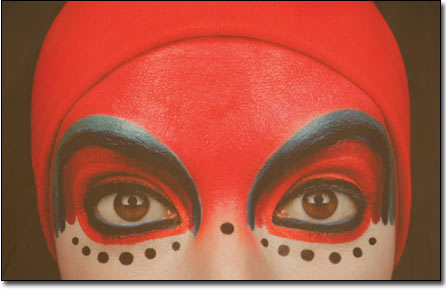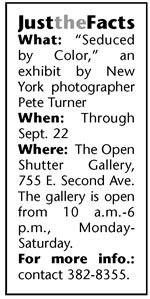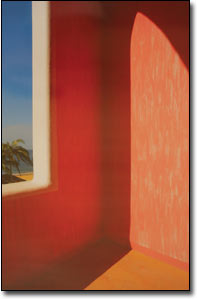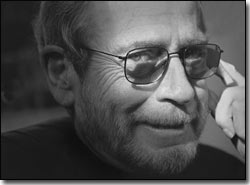 |
| Pete Turner's “Reflections” (Peggy
Moffit), 1970. |
Providing an added sense of sensuality and mystery,
color is the distinguishing and most easily recognizable
element of New York photographer Pete Turner's world-renowned
work. His striking images are on display at The Open
Shutter Gallery in an exhibit entitled, "Seduced by Color."
"Color is the single most graphic element he uses," says
Sara Barry, of the Open Shutter. "It's all about the
intensity. Turner has been on the cutting edge of color
photography for four decades."
 The show spans more than 40 years of Turner's work and
represents the artist's evolution in subject matter from
his early 1950s "African Journey" to "Americana" to his
current "Color of Jazz" and Mexican series. The exhibit
represents Turner's work at home in New York and abroad,
in locales ranging from Baja and Careyes, Mexico, to
Cairo and Capetown, Africa. The show also features a
collection of Turner's international classics. The show spans more than 40 years of Turner's work and
represents the artist's evolution in subject matter from
his early 1950s "African Journey" to "Americana" to his
current "Color of Jazz" and Mexican series. The exhibit
represents Turner's work at home in New York and abroad,
in locales ranging from Baja and Careyes, Mexico, to
Cairo and Capetown, Africa. The show also features a
collection of Turner's international classics.
Although Turner's subjects have shifted over the years,
he consistently relies upon his attraction to color and
intensity, even in his earliest pieces that do not use
filters or pigmentation. In an interview this week, Turner
said he feels that the exhibit's title, "Seduced by Color" is
an appropriate fit for his lifelong work and fascination
with color.
"Ever since I got into color, I've been seduced by it," Turner
said. "As a kid, I was into chemistry and all the chemicals
involved; I liked to mix things together and I liked
the colors of the chemicals, but I think that I really
got into it through stamp collecting."
Turner explains that during World War II his father
was a band leader for an orchestra at the Mount Royal
Hotel in Montreal, Canada. As a young boy, Turner would
play gin rummy with the band members for fun and spare
change for stamp collecting.
"The stamps had all these wonderful colors, it was like
an artist's palette," he said. "There were places that
seemed interesting, which were the icons I remembered.
I can still see the colors."
 |
| Pete Turner's “Pink Arch & Beach,” 2003. |
Color obsession eventually led Turner to an ardent pursuit
of photography. He got his start in the sixth grade working
with a box camera and went on to roles in the high school
newspaper and yearbook. Turner says that his photography
pieces compensated for his below-average grades when
he eventually applied to the Rochester Institute of Technology.
Perhaps Turner's most controversial image, "The Giraffe," was
exhibited at The Metropolitan Museum of Art in 1967.
"Originally the image was a little overexposed for me," he
said. "I wanted to create wonderful colors, to change
the sky from red to magenta, but at that time if you
used filters you'd be a heretic. I decided to basically
break every rule I'd ever been taught in school, but
my best teacher once said there are no rules; once you
know them you should challenge them."
In spite of ample experience and schooling, Turner said
he did not really find his own style until traveling
to Heimaey, Iceland, in 1973 to photograph a volcanic
eruption.
"It was the ultimate reality trip," he said. "I've never
seen anything so real. It was a turning point for me
because I'd seen reality up close and didn't really want
to go the photojournalism route. After that I designed
the photographs I made."
 |
| Photographer Pete Turner’s
exhibit “Seduced
by Color,” a collection of more
than four decades of his cutting edge work, is on
display at the Open sShutter
Gallery through Sept. 22. The exhibit represents
the New York photographer’s
work in Mexico, Africa and home./Photo courtesy Pete
Turner. |
Since then, Turner has received more than 300 awards,
including Professional Photographer of The Year 2000
from the PhotoImaging Manufacturers and Distributors
Association. His work is held in permanent collections
in major international museums and has been showcased
in Europe, Asia, Australia, South America and the United
States.
As Turner has transitioned from black and white to color
prints to his present digital format, so has the content
and intent of his work.
"I've seen a lot of things," says Turner. "The way I
see them has changed and the tools we use have changed."
Turner has, however, noticed constant themes in his
work.
"What a photographer does by nature relates to his subject
matter and what interests him," he said. "I get hooked
on shooting certain things. I guess there are the themes
of color and perspective. I've also always loved geometry,
which has been a constant theme for me."
Through this unique perspective, Turner transforms sand
dunes into cliffs; photographs women on the beach upside
down and turns them into flying birds; and finds grotesque
appeal in photographing a fake eyeball in a bowl of peaches.
In humoring and fooling the onlooker, he also finds some
of the greatest joy in his work.
"I do have a sense of humor," Turner said. "I think
it can be fun when you're not limited to the normal weight
of things."
However, he added that he has yet to define his work
or himself.
"I'm a photographer in search of a title," Turner concluded.
|